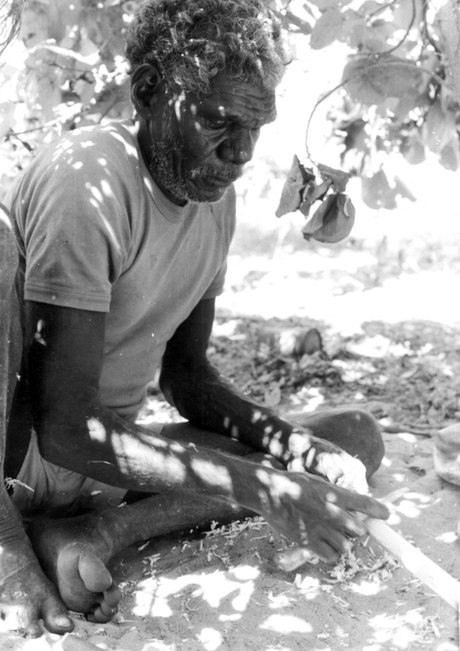NARRITJIN MAYMURU
BIOGRAPHY

Photo © Howard Morphy
At the time of his death in 1981, Narritjin Maymuru along with his brother Nanyin, and a classificatory brother Bokarra were the leaders of the Manggalili clan, a small nomadic group of about fifty people, who lived at Djarrakpi (Cape Shield), in North East Arnhem Land.
As with every clan, the Manggalili are associated with country, totems and design that places them on their rightful place within the North East Arnhem Land social structure. Each has a specific design, which they employ in body painting and artifact decoration for ceremony, as well as in their bark painting. It is as if, all of the clan designs together were a tartan map that covers the entire landscape.
Narritjin’s clan design consisted of diamonds, rows of dashes, anvil shapes and an X pattern that is derived from the breast girdle worn by ancestral women during mourning ceremonies. Narritjin used a brush of human hair, ‘ a marwat ’, to intricately cover the entire surface of his barks in geometric designs. The figurative elements of his compositions remained subservient to seemingly abstracted grid. Human, animal and spirit figures usually appeared in a silhouette black or with limited patterning. The contrast between the stark figurative elements and their intricate background created an optical clarity, but more importantly it highlighted the dominant purpose of Narritjin’s compositions, to relay narratives of great significance.
While the nomadic lifestyle of Narritjin’s people may seem at odds with the central importance in Manggalili culture of the clan and its associated country, art serves to reconcile the two by providing a medium by which one’s clan’s connection to country can be transported across the vast distances necessary to maintain a hunter and gatherer existence. Narritjin’s work tells of the movements of the ancestral beings, most notably the Guwak (koel cuckoo), who, whilst traveling with the Marrngu (possum), created the lagoon and sand dunes of Narritjin’s homelands. In order to portray these lengthy narratives he segmented his barks into schematic panels. Though a particular ‘feature of Manggalili painting is that subdivisions are fluid; they meander in harmony with clan designs rather than introducing harsh vertical and horizontal accents ‘ (Ryan 1990: 24).
In relating these narratives Narritjin maintained his connection to his Djarrakpi homeland despite long intervals of separation from it. However story telling also served as a useful medium for passing on knowledge. Just as Narritjin had learnt clan mythology from his mother’s maternal grandfather Birrikitji at Yirrkala, in turn he taught his children and his brother’s children to paint. They included his sons Manydjilnga and Banapana and his brother’s son Baluka who all gained notoriety as painters and they were followed, in the 1960s, by two of his daughters Bumiti and Galuma.
Narritjin’s willingness to pass on his wealth of knowledge explains his daring steps towards closer contact with European Australians. A relatively harmonious relationship developed between the Yolngu people of Northeast Arhem Land and the mission established at Yirrkala in 1935. Narritjin and Nanyin worked for the missionary Wilbur Chaseling at Yirrkala and the sale of their art had the double benefit of securing funds for the church and for the Yolngu themselves. This mutually beneficial arrangement held out until the establishment of the mining town at the nearby Nhulunbuy. With the town came alcohol, which ravaged the community, prompting many elders to establish permanent outstations outside of Yirrkala. In 1974 Narritjins two eldest sons died, and with his own sudden death in 1981, his dream of an outstation at Djarrakpi lay unfulfilled. Though another five of his children died over the following decade, his remaining clan descendants finally established a homeland centre on Cape Shield in 1995. Painting became the means by which this small settlement could remain viable, a testament to Narritjin’s powerful instruction and commitment to Mangalili culture.
© Adrian Newstead
References
Morphy, Howard. 1989, ‘North East Arnhem Land,’ Windows on the Dreaming, Caruana, W. (ed.), Ellsyd Press, Sydney.
Ryan, J., 1990, Spirit in Land, exhib. cat., National Gallery of Victoria, Melbourne.

